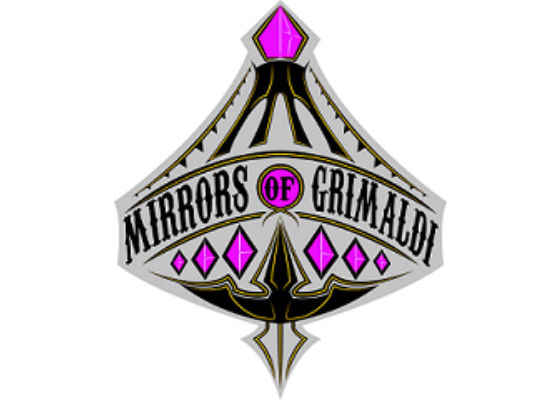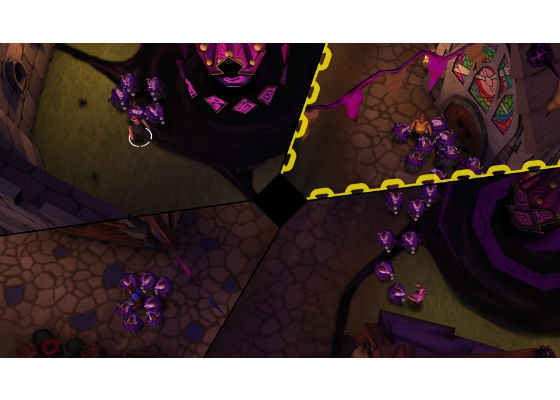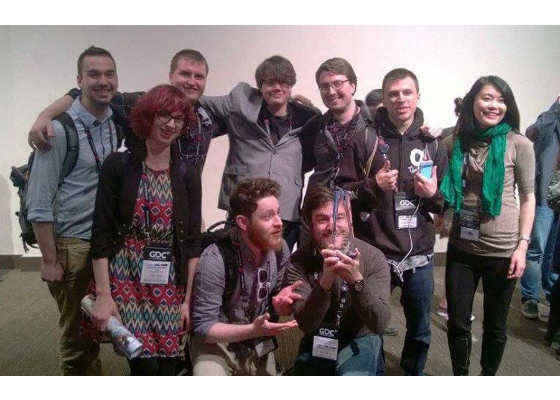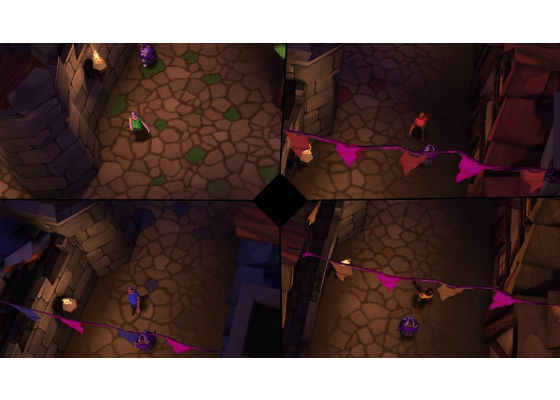Intel Showcases New Talent; Drexel University Punches Through The Competition

Each year, the Intel® University Games Showcase (IUGS), is the place-to-be to get a first look at some of the most innovative interactive entertainment being developed today. Held in conjunction with the Game Developers Conference (GDC), the competition is intense, with teams from the top ten academic game-developer programs in the U.S. competing for recognition, bragging rights, and $35,000 in hardware prizes.
 Survey
SurveyThe third annual showcase, held earlier this year, saw the Best Gameplay award go to Mirrors of Grimaldi, a local multiplayer game developed by the talented 51st and Fire team from Drexel University. A supportive audience, comprising nearly 500 industry professionals, students, the press, and media influencers, was on hand to cheer and encourage. The competition was judged by leading lights from the games industry.
For the Drexel team, the key to winning their category was harnessing the benefits of ideation to come up with a fresh and novel approach to a familiar game concept, namely surviving an attack by a horde of henchmen. This article details the team’s journey from initial concept, through development, to a fully-realized, award-winning game.
Reflecting On Grimaldi
At first glance, Mirrors of Grimaldi looks like a conventional, four-player, split-screen game. (The name, incidentally, references Joseph Grimaldi, a popular English actor of the Regency era who singlehandedly defined our modern image of a clown). Using a medieval, demonic carnival as the backdrop, players are attacked by swarms of evil minions that refuse to die. Your only option to stay alive is to punch your attackers out of your screen and into an opponent’s. But then something unexpected happens.
Mirrors of Grimaldi’s dynamic split screen
As your character’s health waxes or wanes, your screen size expands or shrinks in proportion. This leads to an intriguing dynamic. Becoming weaker risks having the screen collapse around your character, ejecting you from the game. But, conversely, a smaller screen also makes it easier to punch an enemy minion into a neighboring screen, threatening one of your opponents. “We tried to develop gameplay mechanics that use varying screen sizes not just as a feature, but as the principal mechanic of the game,” explained Andrew Lichtsinn, producer of Mirrors of Grimaldi.
In effect, the screen becomes an integral component of the game–“friend or foe” as Lichtsinn describes it–directly affecting how players position themselves, and how they assess threats both on and off their individual screens.
The team that would become 51st and Fire originally coalesced towards the end of the spring term of 2015. After batting several ideas around throughout the summer, the team officially formed in September as part of their senior project in the Digital Media Program. Before reaching the IUGS, however, they had to first get past their fellow classmates. “Drexel hosts an internal competition every year preceding the Games Showcase,” explained Dr. Jichen Zhu, Assistant Professor in the Digital Media Program. Having competed the previous year as a junior, Lichtsinn made it a goal to reach the IUGS in 2016.
Initially consisting of a core group of six members, including a producer, art director, and programmers and artists, the team further reached out to animator Alison Friedlander, as well as programmer Alex Hollander from the College of Computing and Informatics. The team further consulted with an experienced sound designer. “It was a very interdisciplinary team,” noted Zhu.
Drexel’s 51st and Fire team members: (standing from left) Andrew Lichtsinn, Alison Friedlander, Patrick Bastian, Boyd Fox, Evan Freed,
Tom Trahey (front, from left) Steven Yaffe and Alex Hollander. They are joined here by Dr Jichen Zhu (standing, far right)
Ideating Innovation
Ideation was key to developing the core ideas behind Mirrors of Grimaldi’s innovative gameplay. The process began with a series of brainstorming sessions, during which time the team developed more than a dozen roughly hewn game ideas, that they would then share with Zhu. Most failed to impress. But at one point, someone on the team proposed a split-screen approach that was quickly mocked up in Adobe* Photoshop*. “It wasn’t even close to how the game would eventually appear, but Professor Zhu reacted so positively that we knew we were onto something,” recalled Lichtsinn.
From the beginning, Zhu underscored the need to constantly evaluate project scope, especially given the relatively short development window available to the team. At the same time, the team was aware that adopting a split-screen scheme meant more than just creating interesting “visual eye candy,” as Lichtsinn described it. As the ideation evolved, Lichtsinn found everybody on the team contributing core concepts, and helping to develop the game organically.
For instance, one person came up with the idea of punching minions between screens, while someone else hit upon the notion that the minions should never expire. Other team members then suggested random global events, which automatically activate whenever screens haven’t fluctuated enough over a period of time. “The game was a conglomerate of a lot of brainstorming in front of a big whiteboard,” explained Lichtsinn.
Interestingly, Lichtsinn attributes the strength of the gameplay to the fact that there wasn’t a preconceived story idea or theme. “Professor Zhu repeatedly stressed initially keeping story out of the gameplay so we wouldn’t feel constrained,” recalled Lichtsinn. When it came time to craft the surrounding narrative, the idea of a demonic or creepy carnival was immediately popular with everybody on the team. From this, the hall of mirrors grew as a natural metaphor, as the four players essentially progress through mirrored, parallel environments.
In the early stages of the design process, the biggest hurdle turned out to be gesture controls. First and foremost, the team wanted the main action within the game—punching minions—to be an intuitive, fun, and challenging gesture, instead of a button-press. At the same time, they didn’t want a game that had a slippery slope when players start to lose. The solution was to have players charge a punch by rotating the stick, and then flicking in the direction of the punch; larger screens would then necessitate heftier punches with longer charging times. “We wanted players who were winning to have to work a bit harder to keep their lead,” explained Lichtsinn.
For the most part, ideation proceeded smoothly, with few disagreements. “We designed the essence of the game early enough that there wasn’t much disagreement about features,” recalled Lichtsinn. The more contentious questions were about the art, with several competing preferences. For instance, early in development, the team had the idea of using four different character styles, each representing a typical profession of the period. “We ended up having to cut that, because we simply didn't have enough time,” lamented Lichtsinn.
In many cases, final decisions were made either by Lichtsinn or art director Evan Freed. More complex decisions, however, went to a team vote—though that didn’t happen very often. The most notable instance was over the issue of whether the characters should carry weapons, or just punch with their fists. “That one had to go to a vote,” recalled Lichtsinn. “But since our team could fit into a small room, we never got gridlocked, or had to stop production because of competing ideas.”
Crafting With Unity
There was even less contention in the choice of development tools: the Drexel team selected the Unity* engine and used C# for all the programming. “For us, it was a pretty easy choice,” noted Lichtsinn. Not only was a free version of Unity available—Unreal* Engine didn’t offer a similar edition at the time—but since the programmers already had considerable experience with Unity and C#, they felt confident about hitting milestones on time. Moreover, Unity allowed the team to implement a feature and then play it in the editor without forcing a compile, significantly speeding development.
The team adopted an agile system with two-week sprints, and followed each full build with a comprehensive play-test. “We would open the door and invite passing students to try the game,” remembered Lichtsinn. The team also took advantage of a weekly meeting of gaming enthusiasts in Philadelphia called Philly Dev Night, which is affiliated with the Philly Game Forge community. “We collected a lot of data there about what people enjoyed, and what needed improvement,” noted Lichtsinn. “That informed our decisions about what to include in upcoming sprints.”
Mirrors of Grimaldi with four parallel environments
Early on, the team identified rendering as a potential roadblock. While most games only need to render a single camera view, Mirrors of Grimaldi essentially needed to draw four environments at the same time, all while maintaining an acceptable frame-rate. The solution was to narrow the range of textures to four atlases, allowing the game to only have to load four texture files, significantly enhancing performance. Another challenge involved the minion enemies. A strictly AI-driven approach across four environments risked overloading the CPU. Instead, the team adopted a commonly used strategy of pre-rendering much of the AI-based behavior when the minions were offscreen.
These solutions, coupled with custom graphic optimizations done entirely within the Unity framework, were all it took to make Mirrors of Grimaldi shine on the benchmark Intel® graphics-powered laptop. (These computers were supplied by Intel to all participants in the competition.) But the team didn’t stop there, going so far as to test against what Lichtsinn described simply as “a really old laptop” that was unearthed by a team member. “Almost everything we did was developed in-house, allowing our programmers to focus on optimization as needed,” explained Lichtsinn. “This allowed us to make sure that the game could run on as many platforms as possible, even on relatively old systems.”
During all this, time was an ever-present issue; both while readying for the internal competition and when approaching the IUGS. Initially, there was a mad dash to get as much art and features into the game as possible to show to the faculty. “But then, just as we were able to let out a sigh of relief for winning at Drexel, we realized that we had only three more weeks until we had to do it again at the IUGS,” recalled Lichtsinn.
The key to success was identifying the essential elements that showed Mirrors of Grimaldi’s truest value. “I think we definitely hit all those points,” summarized Lichtsinn. “The team really focused and re-focused, making sure the unique gameplay was always at the center of the entire experience,” added Zhu.
Taking It To The Next Level
For the Drexel team, winning the Best Gameplay category at the 2016 Intel University Games Showcase was deeply gratifying. “It meant a lot, and we were all pretty shocked when it happened,” said Lichtsinn. “We felt that we had come up with a great idea, but you never really know until you actually build the game, and see people playing it and having fun.”
The team continues to polish and enhance Mirrors of Grimaldi, and recently made it available on Steam* Greenlight. The plan is to complete final development in 2017, with new maps and game modes, among other features, for distribution in the Steam Store, pricing the game competitively to spur interest. At that point, based on feedback, the team could consider any of several options, including porting to other platforms such as Sony* Playstation* or Microsoft* Xbox*.
In the meantime, the team members take pleasure in knowing that they were able to come up with a stylish game that’s not only fun to play, but also brings something new to the genre. “Most everyone gets at least a little startled when they first see the dynamic split-screen starting to move. That’s great,” enthused Lichtsinn.
SIDEBAR
Tips From The Drexel Team For Pushing The Innovation Envelope
- Encourage all team members, irrespective of role, to participate in the ideation process.
- Think outside the box, literally and figuratively, when developing within a well-established genre.
- When developing new features, consider how to make the enhancements integral to the overall mechanics and gameplay.
- Games are products, and products have deadlines. Pay close attention to how new features affect the scope of the product.
- Choose a development environment that matches your team’s skills, and is in sync with your development methodologies.
- Don’t be afraid to try to startle and delight your audience.
For more such intel resources and tools from Intel on Game, please visit the Intel® Game Developer Zone
Source:https://software.intel.com/en-us/articles/intel-showcases-new-talent-drexel-university-punches-through-the-competition


